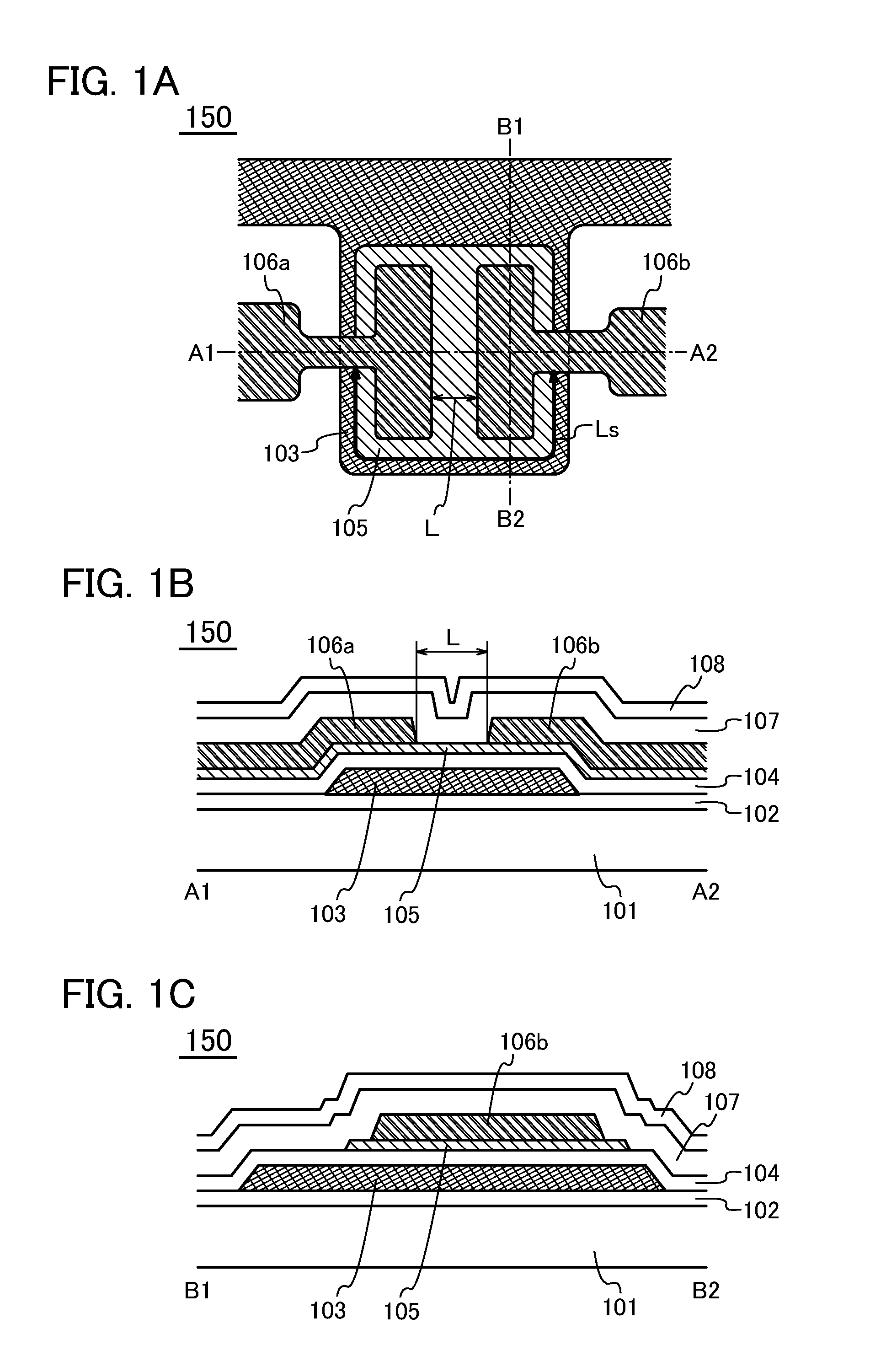Semiconductor device and manufacturing method thereof
a technology of semiconductor devices and manufacturing methods, applied in semiconductor devices, electrical devices, transistors, etc., can solve the problems of not being able to be formed over a larger glass substrate, and achieve the effect of low power consumption and small off-state curren
- Summary
- Abstract
- Description
- Claims
- Application Information
AI Technical Summary
Benefits of technology
Problems solved by technology
Method used
Image
Examples
embodiment 1
[0060]In this embodiment, a transistor in which an oxide semiconductor is used for a semiconductor layer where a channel is formed and a manufacturing method thereof will be described with reference to FIGS. 1A to 1C, FIGS. 2A to 2C, FIGS. 3A to 3C, FIGS. 4A to 4C, FIGS. 5A to 5C, FIGS. 6A to 6C, FIGS. 7A to 7C, and FIGS. 8A and 8B.
[0061]FIG. 1A is a top-view illustrating a structure of a transistor 150 which is one embodiment of a semiconductor device. FIG. 1B is a cross-sectional view illustrating a stacked-layer structure of a portion taken along the chain line A1-A2 in FIG. 1A. FIG. 1C is a cross-sectional view illustrating a stacked-layer structure of a portion taken along the chain line B1-B2 in FIG. 1A. Note that the description of a substrate and an insulating layer are omitted in FIG. 1A.
[0062]The transistor 150 in FIGS. 1A to 1C includes a base layer 102 formed over a substrate 101 and a gate electrode 103 formed over the base layer 102. The transistor 150 further includes...
embodiment 2
[0178]In this embodiment, an example of a process which is partly different from that described in Embodiment 1 will be described with reference to FIGS. 9A to 9C. Note that the same reference numerals are used for the same parts as those in Embodiment 1, and specific description of the parts with the same reference numerals is omitted here.
[0179]First, as in Embodiment 1, the base layer 102 is formed over the substrate 101, and the gate electrode 103 is formed over the base layer 102.
[0180]Then, the gate insulating layer 104 is formed over the gate electrode 103, and a first oxide semiconductor layer with a thickness of 1 nm to 10 nm is formed over the gate insulating layer 104. In this embodiment, the first oxide semiconductor layer is formed to a thickness of 5 nm by using a sputtering gas of oxygen under such conditions that a target for an oxide semiconductor (a target for an In—Ga—Zn-based oxide semiconductor (In2O3: Ga2O3: ZnO=1:1:2 [molar ratio]) is used, the distance betwee...
embodiment 3
[0191]In this embodiment, a method for forming an oxide semiconductor including CAAC-OS, which is different from the method disclosed in Embodiment 2, will be described.
[0192]First, over the gate insulating layer 104, an oxide semiconductor is formed with a thickness of 1 nm to 50 nm.
[0193]The substrate temperature in the film formation is 150° C. to 450° C., preferably 200° C. to 350° C. The deposition is performed while the substrate is heated in the range of 150° C. to 450° C., preferably 200° C. to 350° C., whereby moisture (including hydrogen) or the like is prevented from entering a film. Further, CAAC-OS which is an oxide semiconductor including crystal can be formed.
[0194]Further, it is preferable that hydrogen be further released from the oxide semiconductor and oxygen contained in the gate insulating layer 104 be partly diffused into the oxide semiconductor and the vicinity of the interface of the oxide semiconductor in the gate insulating layer 104 by performing heat trea...
PUM
 Login to View More
Login to View More Abstract
Description
Claims
Application Information
 Login to View More
Login to View More - R&D
- Intellectual Property
- Life Sciences
- Materials
- Tech Scout
- Unparalleled Data Quality
- Higher Quality Content
- 60% Fewer Hallucinations
Browse by: Latest US Patents, China's latest patents, Technical Efficacy Thesaurus, Application Domain, Technology Topic, Popular Technical Reports.
© 2025 PatSnap. All rights reserved.Legal|Privacy policy|Modern Slavery Act Transparency Statement|Sitemap|About US| Contact US: help@patsnap.com



